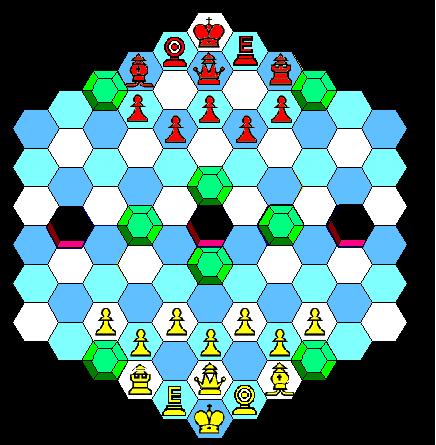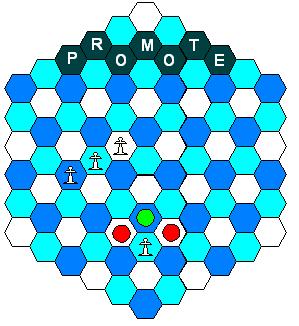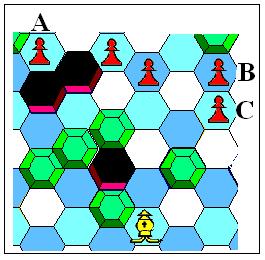Hexagonal Hole Chess
by Gary K Gifford © July 25, 2004

Introduction
One thing I find interesting about hexagonal boards is that the entire board is a hexagon rotated 90 degrees from the smaller hexagons from which it is composed.
I became aware of hexagonal boards through Avalon Hill games and had my interest rekindled when reading about them in R. Wayne Schmittbergers excellent book, New Rules for Classic Games (published by Wiley, 1992). Since I wanted to create an expanded version of my Hole Chess variant (which was created for the 44 squares contest at ChessVariants.com) and since I wanted to make a hexagonal game I combined the two desires and created Hexagonal Hole Chess (HHC).
About Other Hexagonal Games
In 1939 a Soviet geologist, Isaak Grigor'evich Shafran created a version of hexagonal chess and in 1960 the Worldwide Chess Exhibition [in Leipzig] hosted a demonstration of the game. But Shafrans game, even though much closer to western orthodox chess, never gained the popularity seen by Wladyslaw Glinskis version (created in the 1930s). Note that the board Glinski used had also been used in 1912 by Siegmund Wellisch for his three-handed hexagonal chess variant.
Dave McCooey and a friend of his [not named] completed another hexagonal chess variant in 1979.
Both Shafran pawns and McCooey pawns capture diagonally. In hexagonal terms this means that the pawn leaves one hex and enters one of two forward hexes by following the line that connects their closest corners. This diagonal pawn capture results in the pawn ending on the same color hex. (See following figure, right-side image).
Hexagonal Hole Chess makes use of the Glinski pawns, which capture in what I believe is a more visually pleasing orthogonal fashion. Each pawn captures by crossing one of the two 60 degree forward borders of its hex. The pawns new hex will always be a different color. (See following figure, left-side image).

Glinski Pawn Protection vs Shafran / McCooey Pawn Protection
In both cases, the central pawns are protecting the outer two.
McCooey stated that Glinski was possibly not aware of his pawn capture not being diagonal. But I disagree. Glinski was aware of the diagonal Bishop move, diagonal Queen move, how could he not be aware of a diagonal Pawn move? And even if he somehow managed to overlook it, I am most certain that the first players of the game would have questioned the method of capture
.I think that Glinski chose the orthogonal capture because it allows for a very visual display of pawn chains. And those pawn chains look much more like the ones seen in orthodox chess.
Glinskis method, to me, is much more pleasing visually than is the more logical capture. Some have suggested that Shafrans game never gained the success of Glinskis because of marketing. I imagine this is possible. But I think that the visually pleasing pawn chain aspect may be the big factor.
In regard to a few other hexagonal chess variants, Chess Statistician and Historian V. D. Pandit has noted that in 1912 a Viennese engineer by the name of Siegmund Wellisch used the same board as that later used by Glinski but for three players and with 45 pieces total (1 King, 1 Queen, 2 Rooks, 3 Nights and 8 Pawns for each of three players).
Mr. Pandit has also written that J.H.B.Baxter (1964) and Anthony Patton (Englishman staying in Australia, 1975) increased the hexagons "to a whopping 217" with 19 pieces (1 King, 1 Queen, 2 Rooks, 3 Bishops, 2 Knights and 10 Pawns) each side.
The Rules to Hexagonal Hole Chess
The board is identical to Glinskis, except my board makes use of 3 movable holes and 8 movable barriers.

Hexagonal Hole Chess makes use of 1 Rook, 1 Promoted-Shogi Bishop, 1 Queen, 1 Engineer, 1 Teleporter, and 7 pawns (Glinski type).
As in Hole Chess, the Rook, Queen, and PS-Bishop follow a "Two-Action" rule. The Engineer and the Teleporter have no 2-Action Rule, but do have a choice between two types of moves. These actions are explained shortly.
Object
: The object of the game is to capture your opponents King, checkmate your opponents King, or to make your opponents position so unbearable that he or she decides to resign.General
: There are two players. Each player starts with a King, Queen, Rook, PS-Bishop, Engineer, Teleporter, and 7 Pawns. Note that the Engineer looks like the letter "E" over a base. The Teleporter looks like two concentric circles over a base.

How Pawns Move and where they Promote
(Barriers and holes not shown)
The pawns move one space forward, never 2. There is no pawn
en passant. The pawns capture orthogonally through the forward 60° hex borders, as do Glinski pawns. They promote to any other piece (not King) when they reach the promotion zone.In the previous illustration, the pawn chain shows the left-most pawn protecting the one in the center of the chain, and the chains central pawn protecting the right-most pawn.

Normal movement of Pieces
(Barriers and holes not shown)
The Engineer and Teleporter move like a King
The 2-Action Rule
for Queen, Rook, and PS-Bishop onlyThe PS-Bishop, Rook, and Queen have two actions for a given turn, providing that they are the piece to be moved. One of the two actions can be declined for a move, but never both.
Action 1
: The piece moves and possibly captures, as indicated in the previous movement diagrams.Action 2
: The piece targets an opponents piece in its direct line of fire and, as long as a single hole exists in line between the attacker and the target piece, the target is drawn along the line of attack until it falls through the hole, and is thus eliminated.Action 2 cannot be performed if:
- two holes exist between the attacker and the target.
- a barrier is present between the attacker and the target piece.

Above left
the white Rook can draw the PS-Bishop or the Queen through a hole. The red Rook is safe because of the Barrier.Above right The white PS-Bishop can draw the Rook or Red PS-Bishop through a hole. It can also draw the red Queen through the hole because the two barriers align the sides of the diagonal. They do not block it. More about Holes and Barriers is provide near the end of this instruction.
For a Rook, Queen, or PS-Bishop making the move: either action or both actions
can be completed on the same turn. Capture is not mandatory, unless it is the only legal move. Also, a piece can stay where it is and initiate action 2.Because of the Two-Action rule, it is possible to capture two pieces in one turn, i.e., one capture with Action 1 and a second capture with Action 2.
Move or Teleport
Applies to Engineer and Teleporter only.The
Engineer and Teleporter are similar to each other. Both can move 1 hexagon space diagonally or orthogonally in the same manner as the King.As an option to moving, the
Engineer can move any Hole or Barrier which is first in any of his lines of influence (See figure). He can move the Hole or Barrier to any vacant hex, but not off of the board.Likewise, instead of moving, the
Teleporter can move any opponent pawn or piece which is the first in one of his lines of influence (a hex Queen move pattern). He can move the enemy pawn or piece to any vacant hex, with exception that you cannot move a pawn to or beyond its promotion hexes. Teleporters cannot remove pawns or pieces from the board.
The Engineer and Teleporter can move like a King, or they can stay in place to relocate things. Engineers can move a Barrier or a Hole. Teleporters can move an enemy pawn or piece. Do not confuse their lines of influence with their legal moves. When moving like a King the Engineer and Teleporter can capture pieces in the traditional method. Having a movement of 1 they can never pull pieces through holes.
A Word about Holes and Barriers

One may initially be confused by two or more Holes and or Barriers that are in close proximity.
In the above diagram, could a PS-Bishop on Hex-1 move to or capture a piece on Hex-2? Yes. The PS-Bishop, Queen, King, Teleporter, and Engineer could all make that move. The same relation exists with Hex-7 and Hex-8.
When there are two adjacent Barriers or two adjacent Holes,[or even a Barrier and a Hole] the thin diagonal line remains intact. It becomes a bridge over holes and a passage between barriers.
In the above diagram, could a Rook on Hex-3 drag a piece on Hex-4 through the Holes that reside orthogonally between them? No. Because there are two Holes. The dragging ability only works with one Hole between the attacking piece and the target piece.
In the following diagram it is yellows move. On this turn:
- Can the PS-Bishop capture the pawn at "A" ?
- Can the PS-Bishop capture the pawn at "B" ?
- Can the PS-Bishop capture the pawn at "C" ?

Answers:
(1) Yes. A thin diagonal line exists between the adjacent holes and there is
only one Hole directly between the PS-Bishop and the Pawn. Thus the Pawn could
be dragged along the diagonal line between the 2 Holes, then between the 2
Barriers, and then fall through the remaining Hole.
(2) No. The PS-Bishop can move forward one hex and be in alignment with the "B" pawn, but there is no Hole to drag it through.
(3) No, A Barrier is blocking the diagonal.
In Closing
Be aware that there is a situation in which (a) you could pin a piece to a King, (b) that piece could move [putting its King in check], (c) that piece aligns itself with your King and a Hole (d) that piece pulls your King through the Hole. The game ends with the winners King in check but the other King "off the board." This rare occurrence should be understood so you will not be taken by surprise in a game.
Note that there are no stalemates as the stalemated King would simply have to move out into check and be captured.
